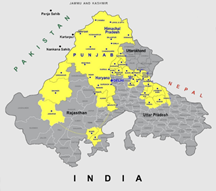

Context
The bilateral ties between India and Canada have deteriorated after Canada alleged “potential" Indian links to the killing of Khalistani separatist leader Hardeep Singh Nijjar (wanted under India’s Terrorist Act) and expelled an Indian diplomat over the issue.
Who was Hardeep Singh Nijjar?
- In June this year Hardeep Singh Nijjar was shot dead outside a Sikh temple in Surrey, British Columbia.
- Nijjar had campaigned for an independent Sikh nation – known as Khalistan – to be carved out of India’s Punjab state.
- He was wanted by Indian authorities and had been designated as a “terrorist” in July 2020.
What is Khalistani movement?
|
The Sikh Empire (faith that arose during the 15th century) was a kingdom in the Punjab region led by Maharaja Ranjit Singh, with the province of Lahore serving as the Sikh capital. |
- Supported by a minority of Indian Sikhs, the Khalistan movement is a separatist and identity movement that advocates, among other things, for carving out an independent Sikh homeland from the Indian state of Punjab.
- The word Khalistan means “Land of the Khalsa” or “Pure.”
- Origin: India’s Punjab state – which is about 58% Sikh and 39% Hindu – was rocked by a violent Khalistan separatist movement (led by preacher Jarnail Singh Bhindranwale) in the 1980s and early 1990s, in which thousands of people died.
- Proposed boundaries: Some claim the entire Indian state of Punjab, while others claim Pakistani Punjab and other parts of North India such as Chandigarh, Haryana and Himachal Pradesh.
- Operation Blue Star: In 1984, Bhindranwale and his followers holed up in the Golden Temple—Sikhism’s holiest site—in Amritsar, Punjab, and fortified it. They were killed by the government in a mission called Operation Bluestar.
- Assassination: In retaliation, Prime Minister Indira Gandhi, who authorized the mission, was assassinated by her own Sikh bodyguards.
- Today, that movement’s most vocal advocates are primarily among the Punjabi overseas diaspora.
- Farmer protestsin New Delhi in 2020–21, led predominantly by Sikhs from Punjab, brought the issue of Khalistan back into the public eye.
- The movement has been outlawed in India, where the government considers it a national security threat.

Proposed Khalistan
|
Other Separatist Movements
|
How the movement received support in Canada?
- The Khalistan movement found supporters among the large and scattered Sikh diaspora, predominantly in Canada, the UK and Australia.
- Canada is home to the largest Sikh population outside Punjab, comprising more than 2% of the country’s population. It also has significant political representation.

What created resentment among Sikhs?
- Partition: The partition of Punjab between Pakistan and India in 1947 created fear and disaffection in the Sikh community.
- They suddenly found themselves divided between a Muslim-majority Pakistan and a predominantly Hindu India.
- Haryana division: In 1966, Punjab was divided again, this time on linguistic lines, as a new Hindi-speaking state of Haryana was carved out of the region.
- Anti-Sikh Violence: The Indian army’s operation in Amritsar (Operation Blue Star) and the anti-Sikh violence in 1984 created an enduring memory for many Sikhs that has transcended India’s borders.
- Inequitable distribution: Punjab’s Sikh community was also impacted by India’s Green Revolution, an initiative in the late 1960s to improve agricultural production. While this benefited Punjab economically, it created resentment among Sikhs due to the inequitable distribution of wealth, the lack of non-agricultural development and the central government’s monopoly over agricultural policy.
- Water distribution: Another issue contributing to the Sikhs’ sense of injustice was the diversion of water from the Sutlej River that flowed through Punjab to the neighbouring states of Haryana and Rajasthan.

|
1985 Bombing (The Violent Peak): In 1985, an Air India flight travelling from Canada to India via London, exploded off the Irish coast, killing all 329 people on board. The bombings were planned by Sikh separatists who wanted to take revenge for the Indian army's deadly 1984 storming of the Golden Temple in Punjab state. |
How have other countries such as the US and EU reacted to the row?
- The West has been rather retrained in their reaction to the ongoing row as they see India as a counterweight to China.
- The Five Eyes — an intelligence-sharing alliance of the US, UK, Australia, Canada and New Zealand — have not extended whole-hearted support to Canada.
- The US is positioning itself as a possible mediator between Ottawa and Delhi.
- Canada’s interests currently pale in comparison to India’s massive strategic importance. It’s unlikely Canada’s allies, including the US, the UK and France, “will cut ties with India due to Trudeau’s allegations”.
What does this mean for Canada-India relations?
- In 2022, India was Canada’s 10th largest trading partner.
- Goods exports to India amounted to $5.4 billion and services exports, $6.2 billion
- Imports from India were $6.4 billion (Goods) and $2.9 billion (Services).
- More than 600 Canadian companies and organisations have a presence in India.
- Bilateral commercial relations between the two countries are worth $100 billion, which includes $70 billion of Canadian portfolio investment in India.
- Students: India has been the largest source country for international students in Canada. In 2022, their number rose 47 per cent to nearly 320,000, accounting for about 40 per cent of total overseas students.

However, if the crisis escalates, trade and investments could take a hit. If Canada imposes restrictions on student visas or the Indian government creates hurdles, it will reduce student inflow. This will hurt Canada as well, as CBIE data show Indian students contributed $4.9 billion to the Canadian economy in 2021.

